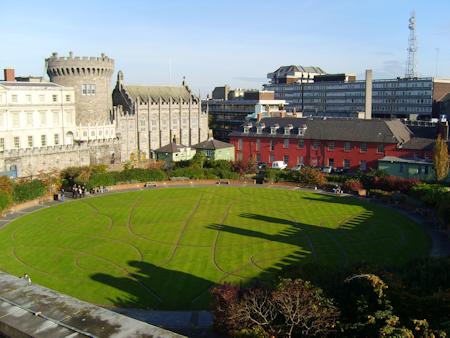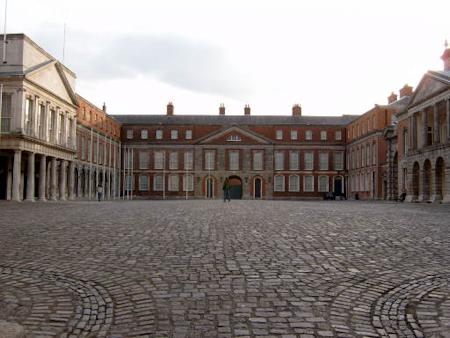
Dublin Castle
Dublin was founded as a Viking settlement in the 9th Century and despite a number of rebellions by the native Irish it remained in the hands of the Norse until the Normans invaded. In 1204 King John I of England ordered the construction of a castle for the defence of the city, to administer justice and to keep the King's treasure safe. It is very likely that the castle was built on an even earlier Viking fortification.
Situated in the heart of Dublin right beside City Hall and close to Trinity College, the castle originally sat by the banks of River Poddle and boats could come in to a pool on the south side. It has been through numerous changes and today it is almost impossible to get an impression of what it looked like during the Middle Ages.
Dublin Castle Layout
A drawing from the late 17th Century shows the castle as a five-sided enclosure with no great tower, but with massive round corner towers. This would make it of a typical Norman courtyard design with a central square, no keep, and bounded on all sides by high defensive walls – the castle walls also forming part of the city walls and defences.
The Record Tower is the most complete surviving portion of the medieval castle to survive. It dates from around 1228, although it was remodelled in the 19th Century when the battlements were added.
The base of the Bermingham Tower is original and can be viewed on the south-western side of the castle complex.
Dublin castle started to rise to prominence during the Elizabethan Wars in the 16th Century. The castle was the seat of a number of Lord Deputies who were powerful, ambitious and ruthless. Parts of the castle were turned into a prison, complete with 'dismal and fetid conditions' and a range of barbaric tortures.
In 1684 the castle suffered from a disastrous fire that destroyed much of the medieval structure. The fire started in the State Rooms and it took no less than three controlled explosions to halt it. The rebuilding work began immediately and in the process the lodgings and State Rooms within the castle were much less fortress-like and much more comfortable.
In the 18th Century Dublin enjoyed a new era of peace and prosperity. The city's population rose significantly during that period and the city expanded rapidly. The castle and the streets surrounding it were extensively remodelled and took on their modern form during this time.
The castle gateway and entrance were rebuilt in line with Cork Hill, and the surrounding streets widened and renamed. The Cork Hill Gate, the Guard House and the Court Marshall room were completed in 1751.
In 1764 there was a munitions explosion in the Armoury which damaged the Ballroom (now St. Patrick's Hall) and the Bermingham Tower which had to be demolished down to its first floor and rebuilt.
Dublin Castle saw action again during the First World War. It was used as a military hospital for British troops wounded on the front lines.
War of Independence
In Easter 1916 there was an insurrection. The troops at the castle were caught completely by surprise and the Volunteer and Citizen Army forces managed to take over the castle gatehouse and Guard House. However, they encountered such little resistance that they thought it must be an ambush and they retreated to Dublin City Hall next door.
The treatment of the leaders of the rebellion turned public opinion against British rule and in 1919 the War of Independence began. Dublin Castle was the headquarters of the British Administration in Ireland. The Republican movement, with Michael Collins at its head, ran a sustained guerrilla campaign against the British Army and the police.
Military officers were ordered to live in the castle and increasing numbers of English civil servants and intelligence staff also took up residence. The castle became quite overcrowded and was the subject of frequent attacks.
The spiral of violence continued, until eventually on 6th December 1921 a truce was called and a peace treaty was signed. On the 16th January 1922 the Castle and its keys were ceremonially handed over to Michael Collins on behalf of the Irish Free State Government and seven centuries of English rule in Ireland came to an end.
Today the castle is still run by the Irish Government. It houses two museums, two cafes, an international conference centre and numerous government buildings. Visitors are free to explore the castle grounds, the Chapel Royal, the Chester Beatty Library, the Garda museum and the Revenue museum. Access to the State Apartments is by guided tour only and you'll need to buy tickets to get in.
The castle has appeared in a number of films including Michael Collins, Becoming Jane and The Medallion. It also hosts the Heineken Green Energy festival each May as well as an on-going cultural programme which includes art exhibitions and theatre performances.
Dublin Castle is still used for important State occasions and for Presidential Inaugurations. On occasions the castle can be closed at short notice for Government business.
Status: Visitor Attraction / Conference Centre / State Functions
Owner: Government of Ireland
Tel: +353 1 645 8813
Email: dublincastle@opw.ie
Website: www.dublincastle.ie
Opening Times: Open Daily Mon to Sat 10am to 4.45pm / Sundays & Bank Holidays 12pm to 4.45pm


The gardens at the rear of Dublin Castle

Inside the courtyard at the castle